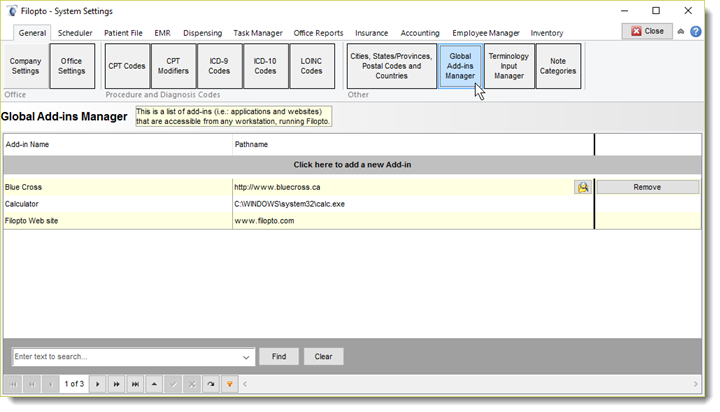
The Add-In Manager, permits users to link external programs, web sites etc.. for use within Filopto. There are two levels of add-ins possibles
1) Local (Personal) add-ins which are specific to a user and
2) Global add-ins which is applied to every user menu.
Add-In can be added at the user Add-in menu for personal add-in or at the Filopto System Settings / Pick List menu for global add-ins.
The System Setting Global Add-Ins Manager option provides the input screen into which you can add, to the Add-in menu, the external resource of your choice.

For example, you can add direct links into Filopto for your Word Processor, for the Windows Calculator applet, or for an Insurance Web Claims Internet site or to WEB Drug Reference Sites (Several drug reference web sites exist such as http://www.rxlist.com, http://www.healthsquare.com, http://www.pdrhealth.com and http://www.fda.gov/cder/index.html among others)
Once added to the Add-Ins Manage option, your program will be automatically displayed in the Tools menu. This tool option is also incorporated in the Invoice screen for direct access to your favorite tools.
IMPORTANT The Add-Ins Manager located on the Filopto menu bar applies the tools you add for the user which is logon only, it is for personal use. The Global Add-ins Manager, located in the system settings will apply the tools entered in it to all users. Both will display the tools entered but global tools cannot be removed or changed via the Personal Add-ins Manager.
|
Add-Ins Manager Option
The Add-ins Manager option locate in the System Settings displays an input screen permitting you to enter the settings of the external program you wish to add to Filopto.
To add a resource, press the + button to add a record to the Add-ins menu. Enter the name of the tool as you wish it to appear in the menu list in the "Add-ins Name" field. Enter the name of the program, folder, document, or Internet resource you wish to use as a tool in the "Pathname" field.
To specify a path, type the drive letter followed by a colon ( : ) and a backslash ( \ ), type the names of the folders and sub folders that contain the file, separating each name with a backslash ( \ ), and then type the name of the file or folder you want to open.
For example, to specify a path to Word Pad located on drive C, you would type:
c:\program files\windows\accessories\wordpad.exe
You can also use the Get Filename button to locate the program on your system.

Once the Add-ins name and Filename are entered, press the check mark button to save your entry.
WEB Site as a Add-ins
To enter a web site, you must enter the web site location as required by your default WEB browser.
For example, to specify a path to the Filopto WEB site, you would type:
http://www.filopto.com
Advanced Program Setting Options:
Allows a user to run specific tools and programs with different permissions than the user's current logon provides. It is good practice for administrators to use an account with restrictive permissions to perform routine, non-administrative tasks, and to use an account with broader permissions only when performing specific administrative tasks. To accomplish this without logging off and back on, log on with a regular user account and use the runas command to run the tools that require the broader permissions.
runas [/profile] [/env] [/netonly] /user:UserAccountName program
Parameters
/profile
Specifies the name of the user's profile, if it needs to be loaded.
/env
Specifies that the current network environment be used instead of the user's local environment.
/netonly
Indicates that the user information specified is for remote access only.
/user:UserAccountName
Specifies the name of the user account under which to run the program. The user account format should be user@domain or domain\user.
program
Specifies the program or command to run using the account specified in /user. For examples of the use of the runas command starting other Windows commands, see Related Topics in the Windows Help menu on your PC.
